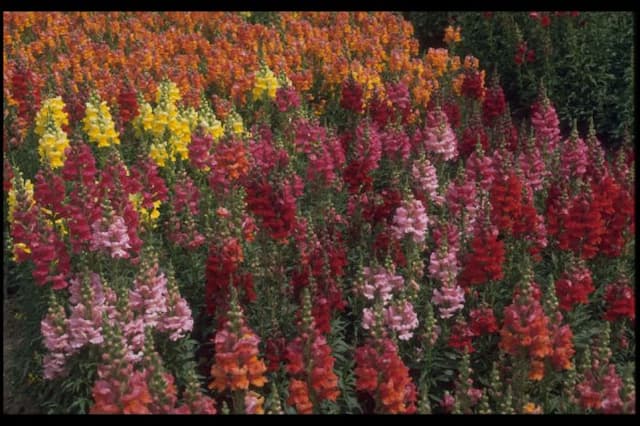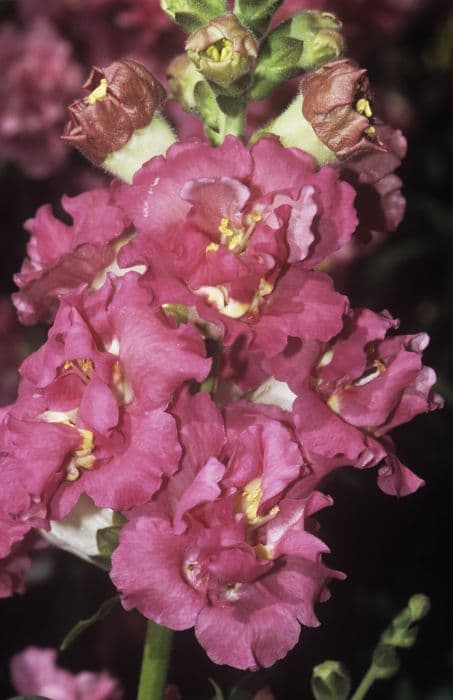Beardtongue Penstemon 'Hidcote Purple'

ABOUT
Penstemon 'Hidcote Purple', commonly known as beardtongue, is a perennial plant celebrated for its striking blooms and garden appeal. The foliage of this cultivar is typically a rich green, forming a backdrop for its distinctive flowers. It grows in an attractive, bushy clump. The most compelling feature of Hidcote Purple beardtongue is its flowers. They are tubular, with a flared opening and a somewhat trumpet-like shape. Each bloom is composed of five petals, with the lower three projecting outward and the upper two creating a hood-like shape. This gives the flowers a two-lipped appearance, which is reminiscent of an open mouth, suggesting the common name "beardtongue." The flowers of the Hidcote Purple come in a deep, saturated purple hue, which adds a vivid splash of color to gardens. These blooms cluster along the plant's stems in dense spikes and offer a lush appearance when they are in full display. The speckled throats in the flowers often provide a contrast to the deep purple petals, adding intricacy and allure to each flower. Aside from the blooms, the textural quality of the plant is also noteworthy. The leaves are lance-shaped, sometimes with a slight serration, giving a robust and full-bodied appearance to the foliage. Overall, the Hidcote Purple beardtongue is a plant with a rich palette of colors and a form that makes for a compelling garden feature. Its lush, vibrant flowers and dense foliage lend it to be a favorite among gardeners looking to add a pop of color and texture to their landscape.
About this plant
 Names
NamesSynonyms
Beardtongue, Penstemon.
Common names
Penstemon 'Hidcote Purple'.
 Characteristics
CharacteristicsLife cycle
Perennials
Foliage type
Deciduous
Color of leaves
Green
Flower color
Purple
Height
2-3 feet (0.6-0.9 meters)
Spread
1-2 feet (0.3-0.6 meters)
Plant type
Herb
Hardiness zones
3-8
Native area
North America
Benefits
 General Benefits
General Benefits- Attracts Pollinators: Penstemon Hidcote Purple is known to attract bees, butterflies, and other pollinating insects, which benefits the overall health of the garden.
- Drought Tolerant: Once established, this plant has low water requirements, making it ideal for water-wise gardens and reducing the need for frequent irrigation.
- Visual Appeal: With its vivid purple flowers, Penstemon Hidcote Purple adds a splash of color and visual interest to garden beds, borders, and landscapes.
- Long Blooming Period: It has a lengthy flowering season, typically from early summer to autumn, providing color for an extended period.
- Low Maintenance: The plant is relatively easy to care for, requiring minimal upkeep beyond the occasional pruning and deadheading to encourage more blooms.
- Versatility: It is suitable for a variety of garden styles, including cottage gardens, rock gardens, and informal borders.
- Hardiness: Penstemon Hidcote Purple can withstand cold temperatures, making it suitable for planting in many climates.
- Wildlife Habitat: It provides a valuable habitat and food source for wildlife, particularly during its blooming season.
 Medical Properties
Medical PropertiesThis plant is not used for medical purposes.
 Air-purifying Qualities
Air-purifying QualitiesThis plant is not specifically known for air purifying qualities.
 Other Uses
Other Uses- Photography Subject: Penstemon 'Hidcote Purple' provides a striking background or focus for garden photographers due to its richly colored blooms.
- Artistic Inspiration: The vibrant purple flowers can inspire artists, who may use them as subjects for paintings, drawings, or textile designs.
- Educational Tool: Educators may use the plant to teach students about pollination, as it attracts bees and butterflies.
- Dye Source: Historically, some Penstemon species' blooms have been used to produce a natural dye; though not common, 'Hidcote Purple' could potentially be used in a similar way.
- Garden Theme Ingredient: The plant can be an essential component in a purple-themed garden or a cottage garden design.
- Culinary Garnish: While not a traditional edible flower, its petals could be used as a decorative, non-toxic garnish for salads or desserts (always ensure edibility before consumption).
- Ice Cube Embellishment: The flowers can be frozen into ice cubes to add a touch of elegance to summer drinks.
- Wildlife Shelter: The dense foliage provides shelter for small beneficial insects and creatures within the garden.
- Fragrant Bouquets: Although not notably fragrant, the subtle scent of 'Hidcote Purple' can contribute to mixed bouquets for a mild aroma.
- Scented Sachets: Dried Penstemon flowers can be included in homemade scented sachets to impart a faint natural fragrance to drawers and closets.
Interesting Facts
 Feng Shui
Feng ShuiThe Beardtongue is not used in Feng Shui practice.
 Zodiac Sign Compitability
Zodiac Sign CompitabilityThe Beardtongue is not used in astrology practice.
 Plant Symbolism
Plant Symbolism- Resilience: Penstemons, including 'Hidcote Purple', are often seen as symbols of resilience because they can thrive in tough, rocky soils and withstand difficult growing conditions.
- Diversity: With the wide variety of colors and forms, penstemons like the 'Hidcote Purple' may represent diversity, celebrating differences and uniqueness.
- Eloquence: The vibrant purple blooms of the 'Hidcote Purple' penstemon might be seen as a representation of eloquence or articulate communication, as flowers have been used historically to convey messages without words.
- Boldness: The striking purple hue of the 'Hidcote Purple' can symbolize boldness and courage, encouraging us to stand out and be seen.
- Balance: Penstemons can represent balance because they have a bilateral symmetry, which may be viewed as a metaphor for the balance one strives for in life.
 Water
WaterBeardtongue requires consistent moisture, but it's essential to avoid overwatering. Water deeply once a week, providing approximately one gallon of water per plant, ensuring the soil is moist but not soggy. During hotter, dry spells, increase the frequency to twice a week. However, if there's substantial rainfall, you can skip the scheduled watering. Adjust the amount of water according to your soil's drainage; sandy soils require more frequent watering than clay soils.
 Light
LightBeardtongue thrives in full sun to partial shade, with at least six hours of sunlight each day being ideal. Place it in a spot where it will receive morning sunlight and partial afternoon shade, especially in hotter climates, to protect it from the intense late-day sun.
 Temperature
TemperatureBeardtongue prefers moderate temperatures and can generally withstand a range from 20°F to 90°F. The ideal growing temperatures are between 55°F and 85°F, ensuring strong growth and flowering. It may survive brief periods outside this range but could suffer damage or become dormant in prolonged extreme conditions.
 Pruning
PruningPrune beardtongue to remove spent flower spikes and encourage a second round of blooms. Pruning is best done immediately after the first flowering has ceased, typically in mid-summer. Deadheading regularly during the blooming season can also promote more flowers.
 Cleaning
CleaningAs needed
 Soil
SoilBeardtongue 'Hidcote Purple' thrives in well-draining soil with a pH ranging from slightly acidic to neutral (pH 5.8 to 7). A mix of garden soil, compost, and perlite or grit will provide the plant with the right structure and nutrients for healthy growth.
 Repotting
RepottingBeardtongue 'Hidcote Purple' doesn't require frequent repotting. Repot every two to three years in spring or when the plant has outgrown its current container to provide fresh soil and encourage new growth.
 Humidity & Misting
Humidity & MistingBeardtongue 'Hidcote Purple' prefers moderate humidity levels common in outdoor environments but does not require any special humidity considerations when grown in such conditions.
 Suitable locations
Suitable locationsIndoor
Bright light, well-draining soil, moderate water.
Outdoor
Full sun to part shade, well-drained soil, shelter from wind.
Hardiness zone
4-9 USDA
 Life cycle
Life cycleThe life of Penstemon 'Hidcote Purple', commonly known as Beardtongue, begins with seed germination, which occurs when soil temperatures are warm and after stratification, if seeds were dormant. Upon sprouting, the seedlings establish a root system and produce a cluster of leaves at the soil surface, growing into a rosette. As the plant matures, it develops sturdy stems and an abundance of narrow, lance-shaped leaves, before flowering in late spring to summer with striking tubular purple blossoms that attract pollinators like bees and hummingbirds. After pollination, the flowers give way to small seed capsules that, once dried, release the seeds for dispersal, thereby completing the reproductive cycle. In the fall, the plant begins to enter dormancy, with the above-ground growth dying back and the plant overwintering with its root system intact. In spring, it re-emerges from the crown, repeating its growth and reproductive cycle.
 Propogation
PropogationPropogation time
Spring-Early Summer
For the Penstemon 'Hidcote Purple', typically called beardtongue, the most popular method of propagation is by seed. The best time to sow seeds is late winter to early spring, just after the last frost when temperatures begin to warm. Seeds should be sown in well-draining soil, lightly covered with soil, and kept moist until germination, which usually occurs within 2 to 3 weeks. Planting in pots or flats can be ideal, as this allows for better control over the moisture and temperature conditions. Once seedlings are strong enough and there is no risk of frost, they can be transplanted to their final location in the garden. It is important to note that beardtongues prefer locations with full sun to partial shade and well-draining soil.





![Snapdragon [Pretty in Pink]](/_next/image?url=https%3A%2F%2Fplants-admin.emdemapps.com%2Fimages%2Fplants%2F%2Fimages%2F604b5cb3b5385.png&w=640&q=75)



